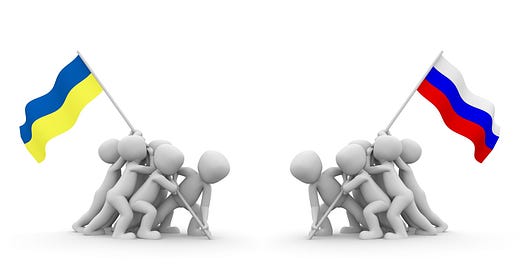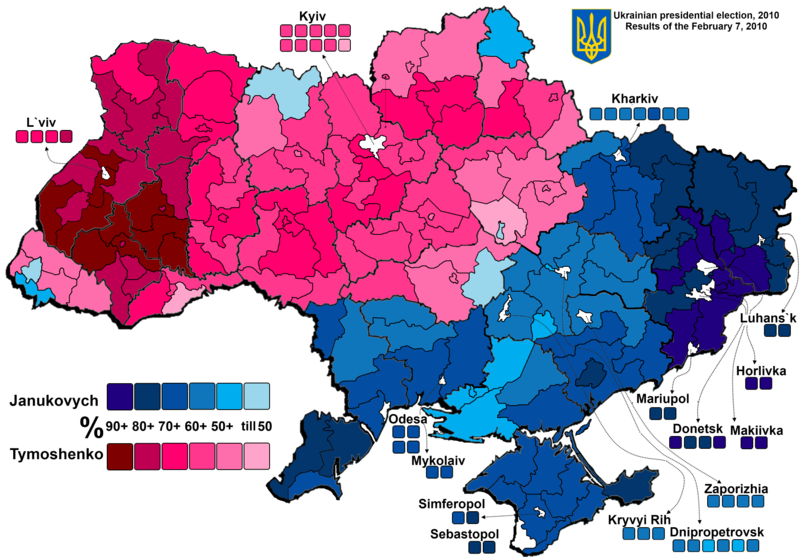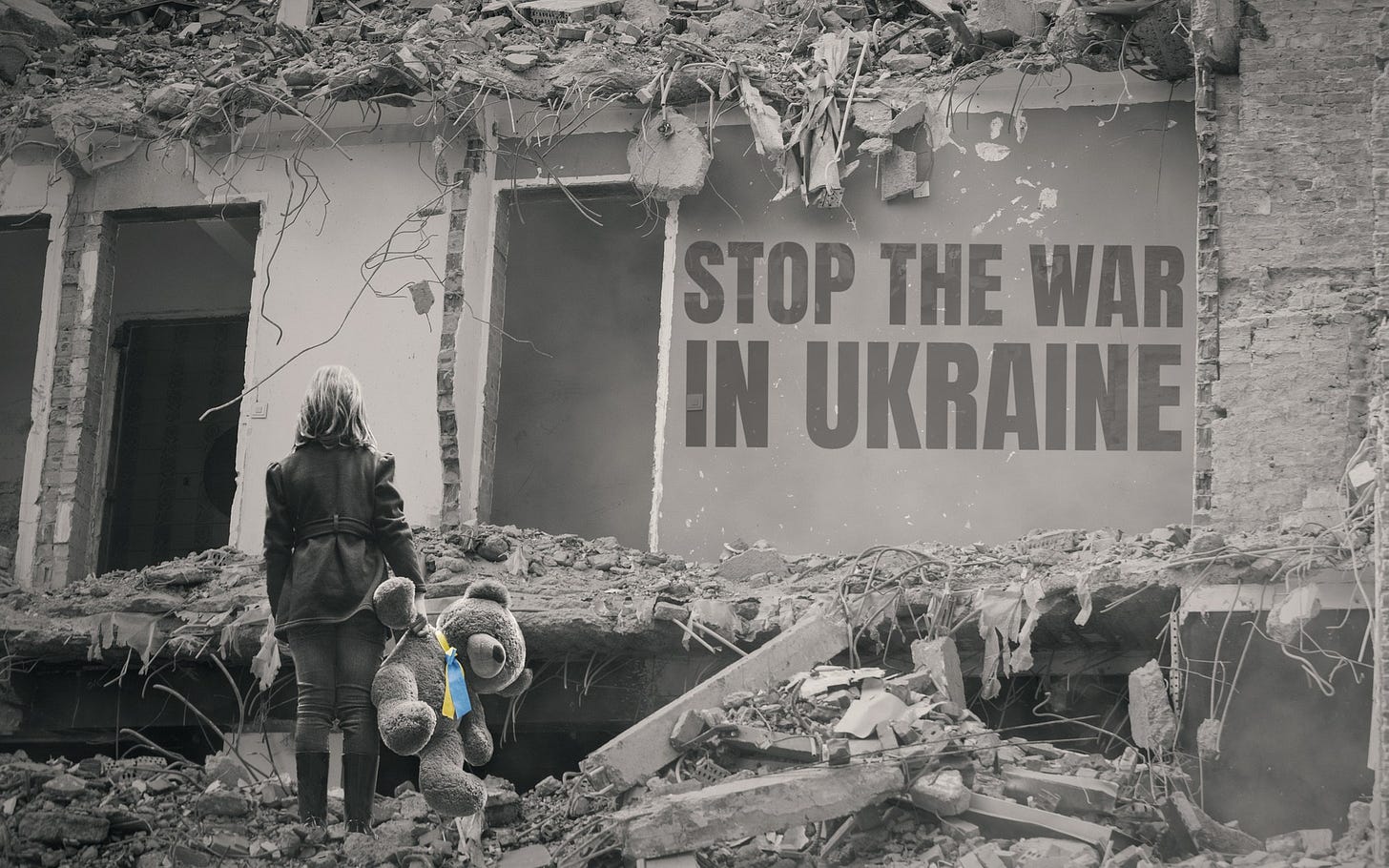Definition:
WAR-
War is an intense armed conflict between states, governments, societies, or paramilitary groups such as mercenaries, insurgents, and militias. It is generally characterized by extreme violence, destruction, and mortality, using regular or irregular military forces.
PROPAGANDA-
Propaganda is communication that is primarily used to influence or persuade an audience to further an agenda, which may not be objective and may be selectively presenting facts to encourage a particular synthesis or perception, or using loaded language to produce an emotional rather than a rational response to the information that is being presented.
THE LONG HISTORY BEHIND THE OUTBREAK OF THE 2014- AND 2022 SEPARATIST WAR
The war in Ukraine is nearing its 1 year anniversary and the main question is of course why did it
1. break out in febr.2022 and
2. not break off since then?
When taking a thorough look at the background and history of the Donbas region/Ukraine- according to (for good and bad) Wikipedia:
https://en.wikipedia.org/wiki/Donbas
5TH-7TH CENTURY:
Area of Ukraine is inhabited by the Early Slavic Antes people, southern migration from ther becoming the ancestral foundation for modern day South Slavic people, northern migration the ancestral roots for Russians.
8TH-13TH CENTURY:
After the dissolution of the Antes Union the Kievan Rus is founded in the late 9th century and -ruled mostly by a Varangian Elite who later assimilates into the slavic populus- flourishes, but later disintegrates into regional power struggles before being completely dissolved following the Mongol invasions of the mid 13th century.
14TH-16TH CENTURY:
Ukraine`s territory gets partitioned between the Kingdom of Poland and the Duchy of Lithuania after the Galicia-Volhynia Wars in 1349 and becomes increasingly settled by Poles during the following century and -following the 1569 joining of Poland and Lithuania under a Commonwealth- de jeur Polish Crown Territory.
The local gentry mostly joining with the Polish Nobility, leaving the local peasants without adequate representation and protection.
The Crimea in that time is a Khanate under Genghis Khan`s descendant prince Haci I Giray, enslaving and exporting ca 2 million Tatars from the region.
17TH-18TH CENTURY:
In the mid 17th century the dissatisfied peasantry and Zaporoszhia (/Dniepre) Cossacks ally themselves, founding the Cossack Hetmanate and fighting against the polish rule. After suffering harsh first defeats they turn to Russia and its Tzar for help, leaving the territory under loyalty-oath to the Russian monarch.
Following subsequent 30 years of devastating war in 1686 the Ukraine`s territory is again partitioned, now between Poland and Russia.
Several Cossack uprisings to free themselves from Russian dominance fail and under Tzaress Catherine the Great the Cossack Hetmanate is completely dissolved, much of Central Ukraine integrated into the Russian Empire (in the years 1764-1782) and in 1783 Crimea annexed as well.
Those territories being officially called "New-Russia", opened up to settlement by Russians and the Ukrainian language and culture supressed.
After the fall of the Polish-Lithuanian Commonwealth in 1795, also the western parts of Ukraine are partitioned, this time between Russia and the Austrian Empire.
19TH CENTURY:
Ukrainian Nationalism is rising, but strongly supressed in the russian-, while watched with leniancy in the austrian occupied regions. Writings in the Ukrainian language being often banned in the former.
When finally joining the Industrial Revolution in the late 19-hundreds the Eastern Regions, especially the Donbas, becomes the center of the country`s productivity due to its rich mineral- and coal-reserves.
This boom of mining industries again leads to a large influx of new settlers to the region of Russian origin, resulting in the phenomenon, that while overall the Ukrainian population of the entire eastern (Donbas) region still remaining a majority of around 52% (in comparison 29% being Russians, the rest divided among Greeks, Germans, Jews and Tartars), this is mostly limited entirely to the rural areas, the main (industrial) cities often becoming purely russian, those relatively few Ukrainians moving there paradoxically thoroughly assimilating into the russian language and culture.
20TH CENTURY:
WW1 AND FOLLOWING-
Due to the countering alliances of Russia and Austria, Ukrainians at first fight confusingly on both sides, but then use the overall disintegration of the Russian Empire to fight their own War for Independance, which ultimately fails and instead sees again the western territories under Poland´s- and the remainder of the country under (now Soviet) Russia`s occupation as the "Ukrainian Soviet Socialist Republic".
The following years of the Russian Civil War sees Ukraine equally badly affected with enormeous casualties and famines especially in its eastern regions, slowly afterwards reconstructing its economy to the pre WW1 level.
While being given some cultural and partly economic freedom again under Lenin, the following Stalin era and its centrally planned economy proves disastrous to the Ukrainian peasantry, culminating in the Holodomor-mass starvation of millions in 1932/33.
In addition, the wider political "Great Purge" of that time affecting and often eliminating much of the Ukrainian intelligentsia.
WW2 AND FOLLOWING-
Following/during Russia`s invasion of Poland in 1939, Ukraines western (former polish-) occupied regions come under Soviet Russia`s rule as well, until being -temporarily- expelled off all of Ukraine by the German Forces during 1942/42.
While the main bulk of central and eastern Ukrainians obviously fighting on the Red Army`s side, the inhabitants of its western regions mostly hail the German Army as liberators and- as also other Nationalist Forces like the Ukrainian Insurgent Army and the Ukrainian Liberation Army- fight on the German side, with an estimated total strength of around 200000 troops.
Post-war Ukraine sees difficult years with famine, large numbers of forced "special deportations" and though official territorial gain (Crimea is given to Ukraine by Khrushchev) the widespread "Russification" policy (https://en.wikipedia.org/wiki/Russification_of_Ukraine) of his predecessors being generally continued.
The example of Leonid Breshnev being illustrative, as he, though long serving Premier of the USSR of officially stated "ukrainian" origin, was actually fully russian.
His parents only moved to Ukraine from Russia shortly before his birth as one of those many earlier described Russian immigrants to its industrial easter regions and he actually never saw himself as ukrainian either, as he explicitly also states in his memoirs.
POST SOVIET/MODERN ERA:
Following the dissolution of the Soviet Union in 1989-1992 Ukraine for the first time in 700 years becomes officially a fully independant state.
The aftermath of 300 years of russian occupation and russian immigration leaving the country with an ethnically/culturally divided populus within, mostly between its eastern and central/western parts, but-as explained before- even partly within those parts, as f.ex. the russian-culture/language dominance in its eastern cities stands against the still mostly ukrainian countryside.
The similarity to the long english occupation and partial settlement of Ireland being striking. In that case also leaving its affected -northern- areas a hot bed of confrontation and friction for generations and finally a secluded entity and de facto own state integrated into the motherland England.
The similar situation in Ukraine also being clearly visible in the following maps (taken from Wikipedia):
A) Russian- versus ukrainian speakers across the country:
B) Map of Electionresults 2010 and respective regional voter distribution:
C) POST 2014 SURVEYS
Results of surveys made after the start of the 2014-, but prior to the 2022 war in those eastern regions showed, that a majority of the population were actually in favor of reintegrating into Ukraine rather than join Russia.:
https://theconversation.com/most-people-in-separatist-held-areas-of-donbas-prefer-reintegration-with-ukraine-new-survey-124849Ukraine
SUMMARY:
On the core belligerents`side we have:
1. UKRAINE and the point of view and sentiment of the original ukrainian people, independant for the first time in 7 centuries, who, after more than three hundred years of suppression and settlement by Russia, have a deep resentment against any further influence/dominance by it and see it as their right to demand full cultural assimilation of the part of the ukrainian citizenry stemming from former russian settlers, as Russia had done to them the other way around for hundreds of years, including the supression of their language.
2. THE UKRAINIAN SEPARATISTS, a - by now over centuries firmly established- large ethnically/culturally russian group of Ukraine`s populus dominating parts of the country`s east, which feel they do and want to belong to their original mother-country and culture and see it as their right to cut off/make fully independant the territories they have settled over hundreds of years from the overall state/government of Ukraine in reaction to its policy of demanding cultural assimilation.
On the side of external powers entering the conflict- and as such bringing in further goals and objectives to bear-:
3. RUSSIA, which regards the factually undeniable strong both overt and covert US-medddling and influence in Ukraine policies since at the latest 2014 and its relentless eastward expansion of the NATO alliance to ever more former Soviet countries and closer to its borders an unacceptable disrespect of its sphere of influence and security concerns.
The russian leadership seeing it as its right to fully annex Crimea (ca 95% russian speaking) and support both overtly and covertly the rebel-fractions of Ukraines East militarily since the 2014 regime change and finally in feb.2022 launch a full invasion into Ukraine to support those regions` governments and stop the ukrainian military`s repeated aggressive actions against them.
4. THE MAIN WESTERN POWERS, NATO AND ESPECIALLY THE US argueing that Ukraine as a fully independant state has the right to chose whatever international alliance/affiliation it wishes to belong to and also how to deal with its domestic separatist- movement without any interference by Russia.
PRESENTATION OF THE CONFLICT IN THE MEDIA
When taking into consideration the above extensive and multifacetted background to the conflict, the widespread simple black and white narrative of Ukraine being the Good- and Russia the Bad Guy launching a "totally unprovoked" invasion in february of 2022 is of course untenable and rather raises the question:
Why is the conflict presented so dominantly -or even exclusively- in this one-sided propagandistic way in our mainstream media?
On the other hand, while alternative media sources frequently offer a refreshing counter-perspective to the former party-line perspective by rightfully emphasizing the many faults of the ukrainian side (abandoning of Minsk-accords, constant shelling of the Donbas regions, war-crimes, corruption, propaganda-narratives..)
-if interested see f.ex. Dr. Kollerstrom`s book "Ukraine: The just war" https://www.podomatic.com/podcasts/sheepfarmstudios/episodes/2022-08-16T08_47_54-07_00-
and the right of Russia to protect its citizens, the question that rises here is:
Is this rather black/white presentation the other way round really the entire truth or is it actually more to be found somewhere in between those 2 opposing narratives?
According to mainstream media the Ukraine has a fair point, Russia not, often according to alternative media Russia has, while Ukraine has not.
Seen in the context of the above long history I would ask if maybe both sides have fair points to some degree which need to be acknowledged and become the basis for a resolution to the conflict?
A resolution which of course will never be found anywhere than through diplomacy anyway.
The only question at this point being how much more needless loss of life and resources will be necessary to finally arrive back at the start (negotiations of march 2022), where it was irresponsibly abandoned in the illusion a resolution could be found anywhere else.







